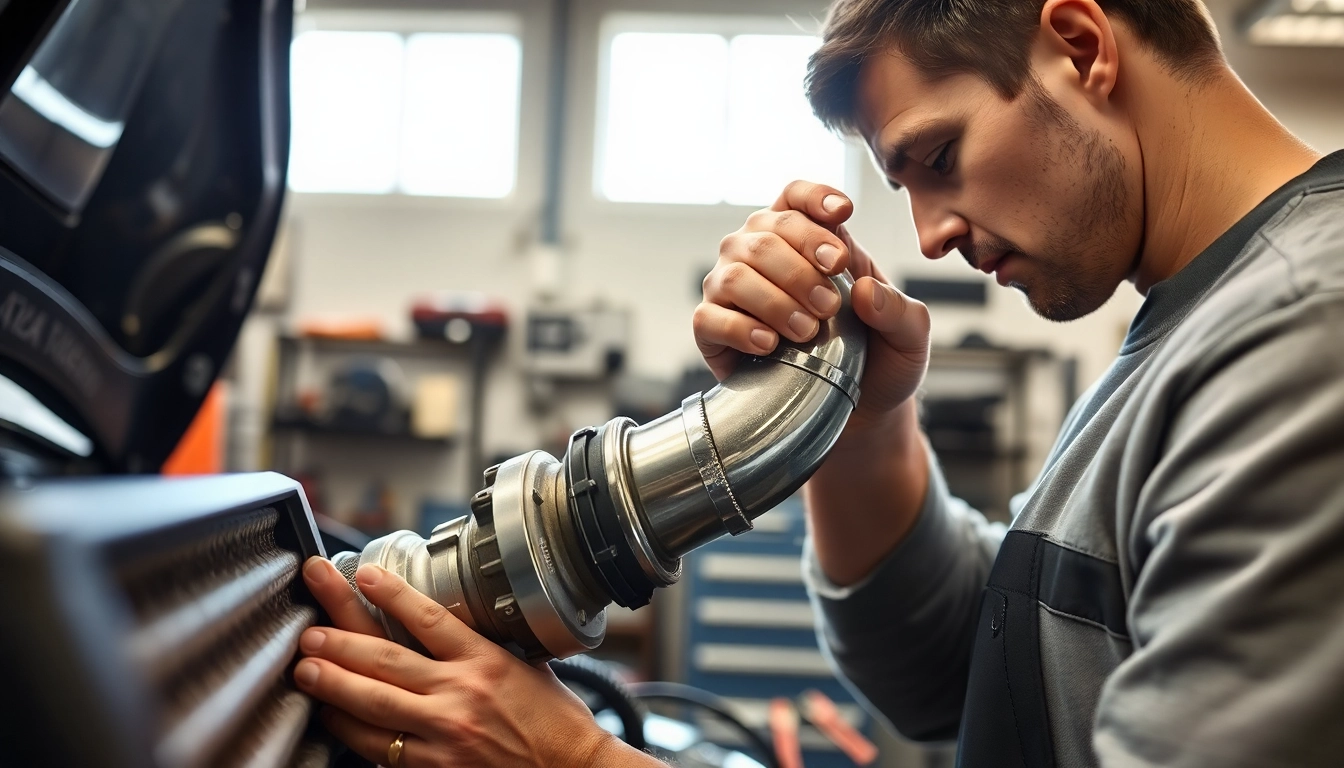
Understanding What Is a Charge Pipe: Function, Benefits, and FAQs
What Is a Charge Pipe?
Definition and Overview
A charge pipe is a crucial component in turbocharged and supercharged engines. It is a specially designed tube that channels compressed air from the intercooler to the engine’s intake manifold. While charge pipes can be made from various materials, they are most commonly constructed from aluminum or high-grade rubber due to their durability and ability to withstand high pressure and temperatures. Understanding the functionality of a charge pipe is important for automotive enthusiasts and anyone looking to enhance their vehicle’s performance. If you’re curious about the intricacies surrounding this component, you might wonder what is a charge pipe and why it matters in vehicle performance.
Materials Used in Charge Pipes
The construction of charge pipes is vital for performance. They can be made from a variety of materials, with the most popular being:
- Aluminum: Lightweight, strong, and capable of dissipating heat effectively, aluminum is often the preferred choice for performance charge pipes. This material also offers a polished aesthetic that many automotive enthusiasts appreciate.
- Stainless Steel: While slightly heavier than aluminum, stainless steel provides superior strength and resistance to corrosion. This makes it an excellent choice for environments where durability is critical.
- Rubber: Rubber charge pipes are more flexible and are typically found in factory-installed setups. While suitable for many standard applications, they may not handle high pressure as effectively as metal alternatives.
Importance of Charge Pipes in Vehicles
Charge pipes play a significant role in the overall performance and efficiency of a vehicle, particularly those equipped with forced induction systems. Their primary function is to effectively route compressed air from the turbocharger or supercharger to the engine. A well-designed charge pipe can greatly enhance an engine’s performance by promoting increased airflow and minimizing the risk of leaks, which can lead to performance issues. By ensuring that the right amount of air reaches the engine, charge pipes help optimize horsepower, fuel efficiency, and throttle response.
Functionality of a Charge Pipe
How Charge Pipes Work
The charge pipe serves as a conduit for the air that has been compressed by the turbocharger or supercharger. This air, containing higher density due to compression, is routed from the intercooler through the charge pipe into the engine’s intake manifold. This process is essential for achieving the ideal air-fuel mixture necessary for efficient combustion. The charge pipe’s design can affect how efficiently this air is delivered, impacting engine responsiveness and power output.
Connection to the Intercooler and Engine
A charge pipe connects two critical components: the intercooler and the engine’s intake manifold. The intercooler cools the compressed air coming from the turbo before it enters the charge pipe, reducing its temperature and increasing its density. A higher density air charge entering the engine allows for better combustion conditions, contributing to enhanced engine performance. Proper alignment and secure connections between the charge pipe and both the intercooler and manifold are crucial to prevent air leaks, which can significantly affect performance.
Components Related to Charge Pipes
Several other components work in conjunction with the charge pipe to optimize engine performance:
- Diverter Valve: This valve controls the flow of air and helps alleviate boost pressure when the throttle closes, preventing compressor surge.
- Blow-off Valve (BOV): Similar to the diverter valve, a blow-off valve releases excess pressure in the system, typically producing a characteristic ‘whoosh’ sound.
- Intercooler: A vital component that cools the compressed air, thereby increasing its density before it enters the engine.
Benefits of Upgrading a Charge Pipe
Performance Improvements
Upgrading to a high-quality charge pipe can lead to significant performance improvements. Enhanced airflow capabilities in aftermarket charge pipes can help optimize engine output. An upgraded charge pipe may allow for quicker spool times from the turbo or supercharger, resulting in improved throttle response and performance during acceleration. Owners who have undergone such upgrades often report noticeable gains in horsepower and torque.
Reducing Risks of Damage
Factory-installed charge pipes are often made from lower-grade materials that can fail under increased stress. Upgrading to a more robust charge pipe reduces the risks of leaks, bursts, and other forms of damage that can arise from high boost levels or extreme temperature fluctuations. This upgrade is particularly important for modified vehicles or those operating under high-performance conditions, where the standard parts may not withstand the demands placed upon them.
Enhanced Airflow and Efficiency
The design of aftermarket charge pipes often includes smoother bends and larger diameter tubing, both of which greatly improve airflow compared to factory options. Enhanced airflow leads to more effective engine breathing, which can enhance fuel efficiency and overall performance. Higher performance charge pipes enable engines to run cooler and operate at optimal conditions, making them an excellent investment for enthusiasts seeking to maximize vehicle performance.
Signs of a Faulty Charge Pipe
Common Symptoms to Watch For
Identifying issues with a charge pipe can prevent larger engine problems. Signs of a faulty charge pipe include:
- Reduced Performance: Both horsepower and throttle response may suffer, indicating a possible air leak in the charge pipe.
- Hissing or Whistling Sounds: Unusual sounds during acceleration can indicate air escaping from a faulty charge pipe.
- Check Engine Light: This could be triggered by a variety of issues, including problems within the charge pipe assembly.
When to Replace a Charge Pipe
If you notice any of the symptoms mentioned above or if your vehicle has undergone significant performance modifications, it may be time to consider replacing the charge pipe. Additionally, regular inspection during routine maintenance can help identify potential issues before they lead to major failures. Taking preventive action is key to maintaining optimal performance.
Potential Impact on Engine Performance
A faulty or failing charge pipe can lead to decreased engine performance and fuel efficiency. Air leaks can cause the engine to run lean (too much air and not enough fuel), leading to potential detonation, increased temperatures, or misfires. This not only affects performance but can also result in costly repairs if not addressed promptly.
Installation and Maintenance of Charge Pipes
Step-by-Step Installation Guide
Installing a charge pipe is a task that can be tackled by those with moderate mechanical skills. Here’s a basic guide:
- Preparation: Gather necessary tools and the new charge pipe. Ensure the engine is cool and the vehicle is parked safely.
- Remove the Old Charge Pipe: Disconnect any associated components (hoses, diverter valve, etc.) and carefully remove the stock charge pipe.
- Install the New Charge Pipe: Align the new charge pipe with the intercooler and intake manifold, securing it in place with the provided clamps.
- Reconnect Components: Reattach any hoses and the diverter valve, ensuring all connections are tight.
- Testing: Start the engine and check for any leaks. Take the vehicle for a test drive to ensure everything operates smoothly.
Regular Maintenance Tips
Maintenance of the charge pipe is crucial for longevity and performance. Here are a few tips:
- Inspect Regularly: Periodically check for cracks, leaks, or signs of wear and tear.
- Secure Connections: Ensure that all clamps and connections remain tight to prevent leaks.
- Clean When Needed: If your charge pipe accumulates oil or debris, clean it to ensure optimal airflow.
Choosing the Right Charge Pipe for Your Vehicle
When selecting a charge pipe, consider factors like:
- Vehicle Model: Ensure that the charge pipe is compatible with your make and model.
- Material: Choose between aluminum, stainless steel, or rubber based on your performance needs and budget.
- Manufacturer Reputation: Opt for reputable brands known for quality and performance enhancements.
